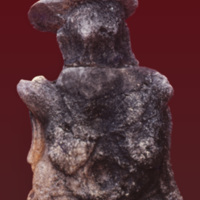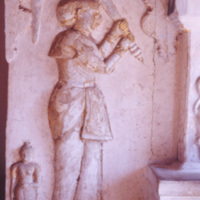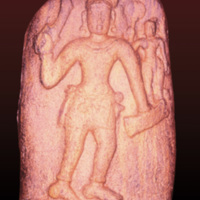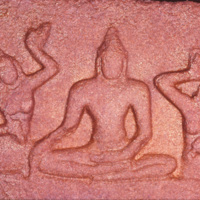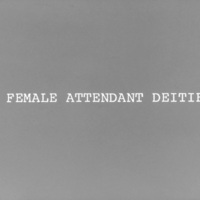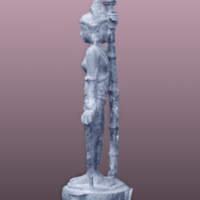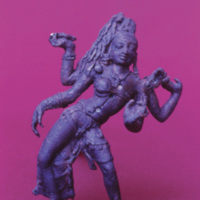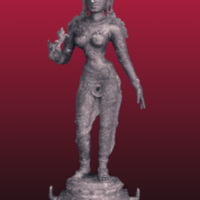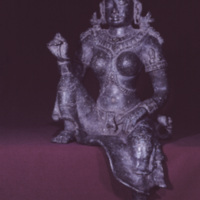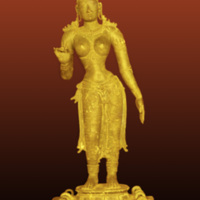Main Menu
AORC Libraries
Browse Archive Items (166 total)
Bahiravi, mythical female
Description: The bahiravas in Sri Lankan art are mythical in character, dwarfish in size and grotesque in appearance. A unique example of a bahirava, this stone figure, which appears to be in a kneeling posture, is placed in the compound of the Vave devalaya at Minneriya, Sri Lanka. It was originally associated with images of other male and female goddesses which are now housed in the inner sanctuary of the develaya. Her dress and ornaments suggest a date in the 3rd or 4th century A.D.
Contributor: Co-Author: Seneviratna, Harsha
Collection: Women in Sri Lankan Sculpture and Painting
Tags: AISLS, Attendant Goddesses, ICES, PDWESLSP
Female attendant
Description: Placed in a palace context, this life-size sculpture of a chamara bearer of the 18th century. It is one of four brick and stucco reliefs carved on the walls of the entrance hall at the royal palace in Kandy, Sri Lanka. They may represent a realistic picture of the type of attendant of royalty during this time, or they may even represent apsaras, for divine status was an attribute of kingship.
Contributor: Co-Author: Seneviratna, Harsha
Collection: Women in Sri Lankan Sculpture and Painting
Tags: AISLS, Attendant Goddesses, ICES, PDWESLSP
Divine maiden (apsara)
Description: At the Archaeological Museum, Anuradhapura, Sri Lanka is this hero stone from Polonnaruva. Here the hero appears in the divine world attended by a female bearing a fan.
Contributor: Co-Author: Seneviratna, Harsha
Collection: Women in Sri Lankan Sculpture and Painting
Tags: AISLS, Attendant Goddesses, ICES, PDWESLSP
Divine maidens (apsaras)
Description: This is the upper section of a hero-stone where an image in the mind’s eye of the hero is shown flanked by two divine maidens or apsaras with chamaras. Ascribed to a period between the 10th and 12th centuries, this relief sculpture, seen at the Archaeological Museum in Anuradhapura, was originally found at a place known as Velanadamana, in the Vilacchi Korale of the North Central Province, Sri Lanka.
Contributor: Co-Author: Seneviratna, Harsha
Collection: Women in Sri Lankan Sculpture and Painting
Tags: AISLS, Attendant Goddesses, ICES, PDWESLSP
Attendant goddesses
Description: Attendant goddesses, both male and female, occupying subordinate positions are a familiar occurrence in early Sri Lankan sculpture. Divine maidens bearing chamaras or fly whisks and sometimes fans, as well as female dwarfs fall into this category.
Contributor: Co-Author: Seneviratna, Harsha
Collection: Women in Sri Lankan Sculpture and Painting
Tags: AISLS, Attendant Goddesses, ICES, PDWESLSP
Ardhanarisvara, hermaphrodite, Half god and half goddess facing opposite directions
Description: Reflecting the Ardhanarisvara concept is this bronze, shown with the male and female halves facing opposite directions. It was originally found in a Buddhist temple at Veragala in the Anuradhapura district, Sri Lanka, The statue exhibited in the Colombo National Museum, may belong to the Anuradhapura period.
Contributor: Co-Author: Seneviratna, Harsha
Collection: Women in Sri Lankan Sculpture and Painting
Tags: AISLS, Composite images, ICES, PDWESLSP
Ardhanarisvara, hermaphrodite, Half god and half goddess
Description: The Ardhanarisvara, half god and half goddess is an expression in art of the essential unity of the male and female in cosmic terms. Belonging to this class of images is an Ardhanari bronze discovered at the Abhayagiri Vihare, Sri Lanka, during excavations connected with the Cultural Triangle Project in 1982. The image is vertically divided into a male on the left and a female half on the right which is unusual. Judging from a tubular knob at the back, it seems to have fitted into a socket in…
Contributor: Co-Author: Seneviratna, Harsha
Collection: Women in Sri Lankan Sculpture and Painting
Tags: AISLS, Composite images, ICES, PDWESLSP
Parvati
Description: This bronze image of Parvati was also found buried near a Siva devalaya at Polonnaruva. It was discovered in 1987 during excavations connected with the Cultural Triangle Project. The image presently displayed at the Colombo National Museum may be attributed to a period around the 12th century A.D.
Contributor: Co-Author: Seneviratna, Harsha
Collection: Women in Sri Lankan Sculpture and Painting
Tags: AISLS, Goddesses in Hindu Worship, ICES, PDWESLSP
Parvati
Description: Another example of a single bronze image of Parvati of about the Cola period found buried together with other Hindu statues is this seated bronze figure. It was found about 300 yards from the Jetavanarama dagoba during the 1984 excavations. The statue is presently stored at the site Museum of the Jetavanarama Cultural Triangle Project in Anuradhapura.
Contributor: Co-Author: Seneviratna, Harsha
Collection: Women in Sri Lankan Sculpture and Painting
Tags: AISLS, Goddesses in Hindu Worship, ICES, PDWESLSP
Parvati as Sivakamasundari
Description: Instances are not rare when Siva and Parvati bronzes were separately cast and placed side by side. The goddess as Sivakamasundari represented by this standing bronze, probably of the Cola period, from the Archaeological Museum, Anuradhapura, Sri Lanka was found buried in a pit behind one of the Siva devalayas at Polonnaruva, Sri Lanka, It is reported that even in this hideout she was found placed in a position of attendance on the male deity.
Contributor: Co-Author: Seneviratna, Harsha
Collection: Women in Sri Lankan Sculpture and Painting
Tags: AISLS, Goddesses in Hindu Worship, ICES, PDWESLSP



